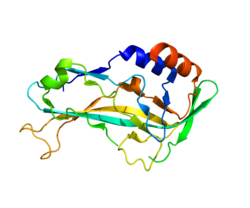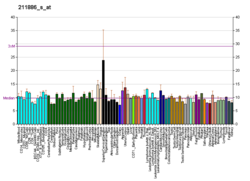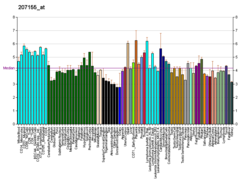TBX5 (gene)
| TBX5 | |||||||||||||||||||||||||||||||||||||||||||||||||||
|---|---|---|---|---|---|---|---|---|---|---|---|---|---|---|---|---|---|---|---|---|---|---|---|---|---|---|---|---|---|---|---|---|---|---|---|---|---|---|---|---|---|---|---|---|---|---|---|---|---|---|---|
 | |||||||||||||||||||||||||||||||||||||||||||||||||||
| |||||||||||||||||||||||||||||||||||||||||||||||||||
| Identifiers | |||||||||||||||||||||||||||||||||||||||||||||||||||
| Aliases | TBX5, HOS, T-box 5, T-box transcription factor 5 | ||||||||||||||||||||||||||||||||||||||||||||||||||
| External IDs | OMIM: 601620; MGI: 102541; HomoloGene: 160; GeneCards: TBX5; OMA:TBX5 - orthologs | ||||||||||||||||||||||||||||||||||||||||||||||||||
| |||||||||||||||||||||||||||||||||||||||||||||||||||
| |||||||||||||||||||||||||||||||||||||||||||||||||||
| |||||||||||||||||||||||||||||||||||||||||||||||||||
| |||||||||||||||||||||||||||||||||||||||||||||||||||
| |||||||||||||||||||||||||||||||||||||||||||||||||||
| Wikidata | |||||||||||||||||||||||||||||||||||||||||||||||||||
| |||||||||||||||||||||||||||||||||||||||||||||||||||
T-box transcription factor TBX5, (T-box protein 5) is a protein that in humans is encoded by the TBX5 gene.[5][6][7] Abnormalities in the TBX5 gene can result in altered limb development, Holt-Oram syndrome, Tetra-amelia syndrome, and cardiac and skeletal problems.
This gene is a member of a phylogenetically conserved family of genes that share a common DNA-binding domain, the T-box. T-box genes encode transcription factors involved in the regulation of developmental processes. This gene is closely linked[clarification needed] to related family member T-box 3 (ulnar mammary syndrome) on human chromosome 12.
TBX5 is located on the long arm of chromosome 12.[8] TBX5 produces a protein called T-box protein 5 that acts as a transcription factor.[9] TBX5 is involved with forelimb and heart development.[10] This gene impacts the early development of the forelimb by triggering fibroblast growth factor, FGF10.[11]
Function
TBX5 is a transcription factor that codes for the protein called T-box 5. The transcription factors it encodes are necessary for development, especially in the pattern formation of upper limbs and cardiac growth.[12] TBX5 is involved with the development of the four heart chambers, the electrical conducting system, and the septum separating the right and left sides of the heart.[13] Along with playing roles in the development of the heart, septum, and electrical system of the heart, it also activates genes that are involved in the development of the upper limbs, the arms and hands.
This gene is also involved in the muscle connective tissue for muscle and tendon patterning. A study showed that deletion of TBX5 in forelimbs causes disruption in the muscle and tendon patterning without affecting the skeleton's development.[14] T-box protein 5 expression is in the cells of the lateral plate mesoderm which form the forelimb bud and the cascade of limb initiation. In its absence, no forelimb bud forms.
The encoded protein plays a major role in limb development, specifically during limb bud initiation.[15] For instance, in chickens Tbx5 specifies forelimb status.[16] The activation of Tbx5 and other T-box proteins by Hox genes activates signaling cascades that involve the Wnt signaling pathway and FGF signals in limb buds.[15] Ultimately, Tbx5 leads to the development of apical ectodermal ridge (AER) and zone of polarizing activity (ZPA) signaling centers in the developing limb bud, which specify the orientation growth of the developing limb.[15] Together with Tbx4, Tbx5 plays a role in patterning the soft tissues (muscles and tendons) of the musculoskeletal system.[17]
As a protein-coding gene, TBX5 encodes for the protein T-box Transcription Factor 5, which is a part of the T-box family of transcription factors. It also interacts with other genes, such as GATA4 and NKX2-5, and the BAF chromatin-remodeling complex to drive and repress gene expression during development.[18]
Role in non-human animals
Mice that were genetically modified to not have the TBX5 gene did not survive gestation, due to the heart not developing past embryonic day E10.5. Mice that only had one working copy of TBX5 were born with morphological problems such as enlarged hearts, atrial and ventral septum defects, and limb malformations similar to those found in the Holt-Oram Syndrome.[19]
Pigeons with feathered feet have Tbx5 active in the hind feet, which cause them to develop feathered hindlimbs with thicker bones, more similar to their frontlimb wings.[20][21]
Role in human embyronic development
A gene "knockout" model for TBX5 by CRISPR/Cas9 genome editing has been created.[22] This homozygous TBX5 knockout human embryonic stem cell line, called TBX5-KO maintained stem cell-like morphology, pluripotency markers, normal karyotype, and could differentiate into all three germ layers in vivo. This cell line can provide an in vitro platform for studying the pathogenic mechanisms and biological function of TBX5 in the heart development.[22] By understanding what happens in development without this gene, further treatment options for fetuses with a TBX5 mutation might be possible to prevent the severe cardiac defects associated with Holt-Oram Syndrome.
Clinical significance
Mutations in this gene can result in Holt–Oram syndrome, a developmental disorder affecting the heart and upper limbs.[23][10] Holt-Oram syndrome can cause a hole in the septum,[9] bone abnormalities in the fingers, wrists, or arms,[24] and a conduction disease leading to abnormal heart rates and arrhythmias.[8] The most common cardiac issue associated with this condition is the malformation of the septum, which separates the left and right sides of the heart.[25]
Tetra-amelia syndrome is a condition where forelimb malformation occurs because FGF-10 is not triggered due to Tbx5 mutations.[26] This condition can lead to the absence of one or both forelimbs.
Skeletally, there may be abnormally bent fingers, sloping shoulders, and phocomelia. Cardiac defects include ventral and atrial septation and problems with the conduction system.[27] Several transcript variants encoding different isoforms have been described for this gene.[7]
Interactions
TBX5 (gene) has been shown to interact with:
References
- ^ a b c GRCh38: Ensembl release 89: ENSG00000089225 – Ensembl, May 2017
- ^ a b c GRCm38: Ensembl release 89: ENSMUSG00000018263 – Ensembl, May 2017
- ^ "Human PubMed Reference:". National Center for Biotechnology Information, U.S. National Library of Medicine.
- ^ "Mouse PubMed Reference:". National Center for Biotechnology Information, U.S. National Library of Medicine.
- ^ Basson CT, Bachinsky DR, Lin RC, Levi T, Elkins JA, Soults J, et al. (January 1997). "Mutations in human TBX5 [corrected] cause limb and cardiac malformation in Holt-Oram syndrome". Nature Genetics. 15 (1): 30–35. doi:10.1038/ng0197-30. PMID 8988165. S2CID 30763654.
- ^ Terrett JA, Newbury-Ecob R, Cross GS, Fenton I, Raeburn JA, Young ID, Brook JD (April 1994). "Holt-Oram syndrome is a genetically heterogeneous disease with one locus mapping to human chromosome 12q". Nature Genetics. 6 (4): 401–404. doi:10.1038/ng0494-401. PMID 8054982. S2CID 30213.
- ^ a b "Entrez Gene: TBX5 T-box 5".
- ^ a b Patel C, Silcock L, McMullan D, Brueton L, Cox H (August 2012). "TBX5 intragenic duplication: a family with an atypical Holt-Oram syndrome phenotype". European Journal of Human Genetics. 20 (8): 863–869. doi:10.1038/ejhg.2012.16. PMC 3400730. PMID 22333898.
- ^ a b Jhang WK, Lee BH, Kim GH, Lee JO, Yoo HW (August 2015). "Clinical and molecular characterisation of Holt-Oram syndrome focusing on cardiac manifestations". Cardiology in the Young. 25 (6): 1093–1098. doi:10.1017/s1047951114001656. PMID 25216260. S2CID 43846874.
- ^ a b Steimle JD, Moskowitz IP (2017). "TBX5: A Key Regulator of Heart Development". Current Topics in Developmental Biology. 122: 195–221. doi:10.1016/bs.ctdb.2016.08.008. PMC 5371404. PMID 28057264.
- ^ Nishimoto S, Wilde SM, Wood S, Logan MP (August 2015). "RA Acts in a Coherent Feed-Forward Mechanism with Tbx5 to Control Limb Bud Induction and Initiation". Cell Reports. 12 (5): 879–891. doi:10.1016/j.celrep.2015.06.068. PMC 4553633. PMID 26212321.
- ^ "TBX5 t-Box Transcription Factor 5 [Homo Sapiens (Human)] - Gene - NCBI". National Center for Biotechnology Information. U.S. National Library of Medicine.
- ^ Boogerd CJ, Evans SM (February 2016). "TBX5 and NuRD Divide the Heart". Developmental Cell. 36 (3): 242–244. doi:10.1016/j.devcel.2016.01.015. PMC 5542051. PMID 26859347.
- ^ Hasson P, DeLaurier A, Bennett M, Grigorieva E, Naiche LA, Papaioannou VE, et al. (January 2010). "Tbx4 and tbx5 acting in connective tissue are required for limb muscle and tendon patterning". Developmental Cell. 18 (1): 148–156. doi:10.1016/j.devcel.2009.11.013. PMC 3034643. PMID 20152185.
- ^ a b c Tickle C (October 2015). "How the embryo makes a limb: determination, polarity and identity". Journal of Anatomy. 227 (4): 418–430. doi:10.1111/joa.12361. PMC 4580101. PMID 26249743.
- ^ Rodriguez-Esteban C, Tsukui T, Yonei S, Magallon J, Tamura K, Izpisua Belmonte JC (April 1999). "The T-box genes Tbx4 and Tbx5 regulate limb outgrowth and identity". Nature. 398 (6730): 814–818. Bibcode:1999Natur.398..814R. doi:10.1038/19769. PMID 10235264. S2CID 4330287.
- ^ Hasson P, DeLaurier A, Bennett M, Grigorieva E, Naiche LA, Papaioannou VE, et al. (January 2010). "Tbx4 and tbx5 acting in connective tissue are required for limb muscle and tendon patterning". Developmental Cell. 18 (1): 148–156. doi:10.1016/j.devcel.2009.11.013. PMC 3034643. PMID 20152185.
- ^ Steimle JD, Moskowitz IP (2017). "TBX5: A Key Regulator of Heart Development". Current Topics in Developmental Biology. 122: 195–221. doi:10.1016/bs.ctdb.2016.08.008. PMC 5371404. PMID 28057264.
- ^ Takeuchi JK, Ohgi M, Koshiba-Takeuchi K, Shiratori H, Sakaki I, Ogura K, et al. (December 2003). "Tbx5 specifies the left/right ventricles and ventricular septum position during cardiogenesis". Development. 130 (24): 5953–5964. doi:10.1242/dev.00797. PMID 14573514. S2CID 209238.
- ^ Boer EF, Van Hollebeke HF, Park S, Infante CR, Menke DB, Shapiro MD (October 2019). "Pigeon foot feathering reveals conserved limb identity networks". Developmental Biology. 454 (2): 128–144. doi:10.1016/j.ydbio.2019.06.015. PMC 6726567. PMID 31247188.
- ^ "Pigeon foot feather genes identified | UNews". unews.utah.edu. Retrieved 28 May 2023.
- ^ a b Zhao T, Bai R, Wu F, Lu WJ, Zhang J (March 2021). "Generation of a TBX5 homozygous knockout embryonic stem cell line (WAe009-A-45) by CRISPR/Cas9 genome editing". Stem Cell Research. 51: 102156. doi:10.1016/j.scr.2021.102156. PMID 33497883. S2CID 231753691.
- ^ Virdis G, Dessole M, Dessole S, Ambrosini G, Cosmi E, Cherchil PL, Capobianco G (2016). "Holt Oram syndrome: a case report and review of the literature". Clinical and Experimental Obstetrics & Gynecology. 43 (1): 137–139. doi:10.12891/ceog3060.2016. PMID 27048037. S2CID 11803484.
- ^ Pizard A, Burgon PG, Paul DL, Bruneau BG, Seidman CE, Seidman JG (June 2005). "Connexin 40, a target of transcription factor Tbx5, patterns wrist, digits, and sternum". Molecular and Cellular Biology. 25 (12): 5073–5083. doi:10.1128/mcb.25.12.5073-5083.2005. PMC 1140596. PMID 15923624.
- ^ "Holt-Oram Syndrome". Medlineplus Genetics. U.S. National Library of Medicine. 18 August 2020.
- ^ Niemann S (1993), "Tetra-Amelia Syndrome – RETIRED CHAPTER, FOR HISTORICAL REFERENCE ONLY", Tetra-Amelia Syndrome, GeneReviews, University of Washington, Seattle, PMID 20301453
- ^ Packham EA, Brook JD (April 2003). "T-box genes in human disorders". Human Molecular Genetics. 12 Spec No 1 (Spec No 1): R37–R44. doi:10.1093/hmg/ddg077. PMID 12668595.
- ^ a b Garg V, Kathiriya IS, Barnes R, Schluterman MK, King IN, Butler CA, et al. (July 2003). "GATA4 mutations cause human congenital heart defects and reveal an interaction with TBX5". Nature. 424 (6947): 443–447. Bibcode:2003Natur.424..443G. doi:10.1038/nature01827. PMID 12845333. S2CID 4304709.
- ^ Hiroi Y, Kudoh S, Monzen K, Ikeda Y, Yazaki Y, Nagai R, Komuro I (July 2001). "Tbx5 associates with Nkx2-5 and synergistically promotes cardiomyocyte differentiation". Nature Genetics. 28 (3): 276–280. doi:10.1038/90123. PMID 11431700. S2CID 13250085.
Further reading
- Simon H (April 1999). "T-box genes and the formation of vertebrate forelimb- and hindlimb specific pattern". Cell and Tissue Research. 296 (1): 57–66. doi:10.1007/s004410051266. PMID 10199965. S2CID 44834807.
- Packham EA, Brook JD (April 2003). "T-box genes in human disorders". Human Molecular Genetics. 12 Spec No 1 (Spec No 1): R37–R44. doi:10.1093/hmg/ddg077. PMID 12668595.
- Li QY, Newbury-Ecob RA, Terrett JA, Wilson DI, Curtis AR, Yi CH, et al. (January 1997). "Holt-Oram syndrome is caused by mutations in TBX5, a member of the Brachyury (T) gene family". Nature Genetics. 15 (1): 21–29. doi:10.1038/ng0197-21. PMID 8988164. S2CID 22619598.
- Basson CT, Huang T, Lin RC, Bachinsky DR, Weremowicz S, Vaglio A, et al. (March 1999). "Different TBX5 interactions in heart and limb defined by Holt-Oram syndrome mutations". Proceedings of the National Academy of Sciences of the United States of America. 96 (6): 2919–2924. Bibcode:1999PNAS...96.2919B. doi:10.1073/pnas.96.6.2919. PMC 15870. PMID 10077612.
- Yang J, Hu D, Xia J, Yang Y, Ying B, Hu J, Zhou X (June 2000). "Three novel TBX5 mutations in Chinese patients with Holt-Oram syndrome". American Journal of Medical Genetics. 92 (4): 237–240. doi:10.1002/(SICI)1096-8628(20000605)92:4<237::AID-AJMG2>3.0.CO;2-G. PMID 10842287.
- Hatcher CJ, Goldstein MM, Mah CS, Delia CS, Basson CT (September 2000). "Identification and localization of TBX5 transcription factor during human cardiac morphogenesis". Developmental Dynamics. 219 (1): 90–95. doi:10.1002/1097-0177(200009)219:1<90::AID-DVDY1033>3.0.CO;2-L. PMID 10974675. S2CID 21081225.
- Hatcher CJ, Kim MS, Mah CS, Goldstein MM, Wong B, Mikawa T, Basson CT (February 2001). "TBX5 transcription factor regulates cell proliferation during cardiogenesis". Developmental Biology. 230 (2): 177–188. doi:10.1006/dbio.2000.0134. PMID 11161571.
- Cross SJ, Ching YH, Li QY, Armstrong-Buisseret L, Spranger S, Lyonnet S, et al. (October 2000). "The mutation spectrum in Holt-Oram syndrome". Journal of Medical Genetics. 37 (10): 785–787. doi:10.1136/jmg.37.10.785. PMC 1757164. PMID 11183182.
- Hiroi Y, Kudoh S, Monzen K, Ikeda Y, Yazaki Y, Nagai R, Komuro I (July 2001). "Tbx5 associates with Nkx2-5 and synergistically promotes cardiomyocyte differentiation". Nature Genetics. 28 (3): 276–280. doi:10.1038/90123. PMID 11431700. S2CID 13250085.
- Akrami SM, Winter RM, Brook JD, Armour JA (December 2001). "Detection of a large TBX5 deletion in a family with Holt-Oram syndrome". Journal of Medical Genetics. 38 (12): 44e–44. doi:10.1136/jmg.38.12.e44. PMC 1734777. PMID 11748310.
- He ML, Chen Y, Peng Y, Jin D, Du D, Wu J, et al. (September 2002). "Induction of apoptosis and inhibition of cell growth by developmental regulator hTBX5". Biochemical and Biophysical Research Communications. 297 (2): 185–192. doi:10.1016/S0006-291X(02)02142-3. PMID 12237100.
- Fan C, Liu M, Wang Q (March 2003). "Functional analysis of TBX5 missense mutations associated with Holt-Oram syndrome". The Journal of Biological Chemistry. 278 (10): 8780–8785. doi:10.1074/jbc.M208120200. PMC 1579789. PMID 12499378.
- Garg V, Kathiriya IS, Barnes R, Schluterman MK, King IN, Butler CA, et al. (July 2003). "GATA4 mutations cause human congenital heart defects and reveal an interaction with TBX5". Nature. 424 (6947): 443–447. Bibcode:2003Natur.424..443G. doi:10.1038/nature01827. PMID 12845333. S2CID 4304709.
- Huang T, Lock JE, Marshall AC, Basson C, Seidman JG, Seidman CE (2003). "Causes of clinical diversity in human TBX5 mutations". Cold Spring Harbor Symposia on Quantitative Biology. 67: 115–120. doi:10.1101/sqb.2002.67.115. PMID 12858531.
- Collavoli A, Hatcher CJ, He J, Okin D, Deo R, Basson CT (October 2003). "TBX5 nuclear localization is mediated by dual cooperative intramolecular signals". Journal of Molecular and Cellular Cardiology. 35 (10): 1191–1195. doi:10.1016/S0022-2828(03)00231-1. PMID 14519429.
- Steimle JD, Moskowitz IP (2017). "TBX5: A Key Regulator of Heart Development". Current Topics in Developmental Biology. 122: 195–221. doi:10.1016/bs.ctdb.2016.08.008. PMC 5371404. PMID 28057264.
External links
- GeneReviews/NCBI/NIH/UW entry on Holt-Oram Syndrome
- TBX5+protein,+human at the U.S. National Library of Medicine Medical Subject Headings (MeSH)
- v
- t
- e
(1) Basic domains | |||||||||||||||||||||||||
|---|---|---|---|---|---|---|---|---|---|---|---|---|---|---|---|---|---|---|---|---|---|---|---|---|---|
| |||||||||||||||||||||||||
(2) Zinc finger DNA-binding domains | |||||||||||||||||||||||||||
|---|---|---|---|---|---|---|---|---|---|---|---|---|---|---|---|---|---|---|---|---|---|---|---|---|---|---|---|
| |||||||||||||||||||||||||||
(3) Helix-turn-helix domains | |||||||||||||||||||||
|---|---|---|---|---|---|---|---|---|---|---|---|---|---|---|---|---|---|---|---|---|---|
| |||||||||||||||||||||
(4) β-Scaffold factors with minor groove contacts | |||||||||||||||||||
|---|---|---|---|---|---|---|---|---|---|---|---|---|---|---|---|---|---|---|---|
| |||||||||||||||||||
(0) Other transcription factors | |||||||||
|---|---|---|---|---|---|---|---|---|---|
| |||||||||



















